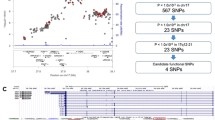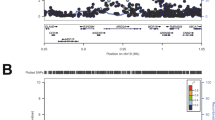Abstract
Aims
Aimed to identify a new susceptibility gene associated with primary biliary cholangitis (PBC) in Chinese Han and investigate the possible mechanism of that gene in PBC.
Methods
A total of 466 PBC and 694 healthy controls (HC) were included in our study, and genotyping GTF2I gene variants by Sequenom. CD19 + B cells were isolated for Chromatin immunoprecipitation sequencing (ChIP-seq). Additionally, MEME-ChIP was utilized to perform searches for known motifs and de novo motif discovery. The GTF2I ChIP-seq of hematopoietic cell line (K562) results were obtained from ENCODE (GSE176987, GSE177691). The Genomic HyperBrowser was used to determine overlap and hierarchal clustering between ours and ENCODE datasets.
Results
The frequency of the rs117026326 variant T allele was significantly higher in PBC patients than that in HC (20.26% compared with 13.89%, Pc = 1.09E-04). Furthermore, we observed an elevated proportion of GTF2I binding site located in the upstream and 5ʹ UTR of genes in PBC in comparison with HC. Additionally, an in-depth analysis of IL21R region revealed that GTF2I might bind to the IL21R promoter to regulate the expression of the IL21R, with four peaks of GTF2I binding sites, including three increased binding sites in upstream, one increased binding site in 5' UTR. Motif analysis by MEME-ChIP uncovered five significant motifs. A significant overlap between our ChIP and GSE176987, GSE17769 were found by the Genomic HyperBroswer.
Conclusions
Our study confirmed that GTF2I was associated with PBC in Chinese Han. Furthermore, our gene function analysis indicated that IL21R may be the target gene regulated by GTF2I.



Similar content being viewed by others
Data availability
The data underlying this article will be shared on reasonable request to the corresponding author.
References
Gulamhusein AF, Hirschfield GM. Primary biliary cholangitis: pathogenesis and therapeutic opportunities. Nat Rev Gastroenterol Hepatol. 2020;17(2):93–110
Liu H, Liu Y, Wang L, et al. Prevalence of primary biliary cirrhosis in adults referring hospital for annual health check-up in Southern China. BMC Gastroenterol. 2010;10:100
Zeng N, Duan W, Chen S, et al. Epidemiology and clinical course of primary biliary cholangitis in the Asia-Pacific region: a systematic review and meta-analysis. Hepatol Int. 2019;13(6):788–799
Lleo A, Leung PSC, Hirschfield GM, Gershwin EM. The pathogenesis of primary biliary cholangitis: a comprehensive review. Semin Liver Dis. 2020;40(1):34–48
Selmi C, Bowlus CL, Gershwin ME, Coppel RL. Primary biliary cirrhosis. Lancet (London, England). 2011;377(9777):1600–1609
Quarneti C, Muratori P, Lalanne C, et al. Fatigue and pruritus at onset identify a more aggressive subset of primary biliary cirrhosis. Liver Int. 2015;35(2):636–641
Colapietro F, Lleo A, Generali E. Antimitochondrial antibodies: from bench to bedside. Clin Rev Allergy Immunol. 2022;63(2):166–177
Granito A, Muratori P, Muratori L, et al. Antinuclear antibodies giving the ‘multiple nuclear dots’ or the ‘rim-like/membranous’ patterns: diagnostic accuracy for primary biliary cirrhosis. Aliment Pharmacol Ther. 2006;24(11–12):1575–1583
Granito A, Muratori P, Muratori L, et al. Antibodies to SS-A/Ro-52kD and centromere in autoimmune liver disease: a clue to diagnosis and prognosis of primary biliary cirrhosis. Aliment Pharmacol Ther. 2007;26(6):831–838
Nakamura M, Nishida N, Kawashima M, et al. Genome-wide association study identifies TNFSF15 and POU2AF1 as susceptibility loci for primary biliary cirrhosis in the Japanese population. Am J Hum Genet. 2012;91(4):721–728
Cordell HJ, Han Y, Mells GF, et al. International genome-wide meta-analysis identifies new primary biliary cirrhosis risk loci and targetable pathogenic pathways. Nat Commun. 2015;6:8019
Sun C, Molineros JE, Looger LL, et al. High-density genotyping of immune-related loci identifies new SLE risk variants in individuals with Asian ancestry. Nat Genet. 2016;48(3):323–330
Kawashima M, Hitomi Y, Aiba Y, et al. Genome-wide association studies identify PRKCB as a novel genetic susceptibility locus for primary biliary cholangitis in the Japanese population. Hum Mol Genet. 2017;26(3):650–659
Qiu F, Tang R, Zuo X, et al. A genome-wide association study identifies six novel risk loci for primary biliary cholangitis. Nat Commun. 2017;8:14828
Wang C, Zheng X, Jiang P, et al. Genome-wide association studies of specific antinuclear autoantibody subphenotypes in primary biliary cholangitis. Hepatology. 2019;70(1):294–307
Nathany S, Tripathi R, Mehta A. Gene of the month: GTF2I. J Clin Pathol. 2021;74(1):1–4
Kozel BA, Barak B, Kim CA, et al. Williams syndrome. Nat Rev Dis Primers. 2021;7(1):42
Li Y, Zhang K, Chen H, et al. A genome-wide association study in Han Chinese identifies a susceptibility locus for primary Sjögren’s syndrome at 7q11.23. Nat Genet. 2013;45(11):1361–1365
Liu C, Yan S, Chen H, et al. Association of GTF2I, NFKB1, and TYK2 regional polymorphisms with systemic sclerosis in a CHinese Han population. Front Immunol. 2021;12: 640083
Li Y, Li P, Chen S, et al. Association of GTF2I and GTF2IRD1 polymorphisms with systemic lupus erythematosus in a Chinese Han population. Clin Exp Rheumatol. 2015;33(5):632–638
Zhao J, Ma J, Deng Y, et al. A missense variant in NCF1 is associated with susceptibility to multiple autoimmune diseases. Nat Genet. 2017;49(3):433–437
Kim K, Bang SY, Ikari K, et al. Association-heterogeneity mapping identifies an Asian-specific association of the GTF2I locus with rheumatoid arthritis. Sci Rep. 2016;6:27563
Yokoyama N, Kawasaki A, Matsushita T, et al. Association of NCF1 polymorphism with systemic lupus erythematosus and systemic sclerosis but not with ANCA-associated vasculitis in a Japanese population. Sci Rep. 2019;9(1):16366
Wang L, Zhang FC, Chen H, et al. Connective tissue diseases in primary biliary cirrhosis: a population-based cohort study. World J Gastroenterol. 2013;19(31):5131–5137
Heathcote EJ. Management of primary biliary cirrhosis. The American association for the study of liver diseases practice guidelines. Hepatology. 2000;31(4):1005–1013
Lindor KD, Gershwin ME, Poupon R, Kaplan M, Bergasa NV, Heathcote EJ. Primary biliary cirrhosis. Hepatology. 2009;50(1):291–308
Abascal F, Acosta R, Addleman NJ, et al. Expanded encyclopaedias of DNA elements in the human and mouse genomes. Nature. 2020;583(7818):699–710
Sandve GK, Gundersen S, Johansen M, et al. The genomic HyperBrowser: an analysis web server for genome-scale data. Nucleic Acids Res. 2013;41(W1):W133–W141
Buniello A, MacArthur JAL, Cerezo M, et al. The NHGRI-EBI GWAS Catalog of published genome-wide association studies, targeted arrays and summary statistics 2019. Nucleic Acids Res. 2019;47(D1):D1005–D1012
Rajaiya J, Nixon JC, Ayers N, Desgranges ZP, Roy AL, Webb CF. Induction of immunoglobulin heavy-chain transcription through the transcription factor Bright requires TFII-I. Mol Cell Biol. 2006;26(12):4758–4768
Mehta DS, Wurster AL, Grusby MJ. Biology of IL-21 and the IL-21 receptor. Immunol Rev. 2004;202:84–95
Long D, Chen Y, Wu H, Zhao M, Lu Q. Clinical significance and immunobiology of IL-21 in autoimmunity. J Autoimmun. 2019;99:1–14
Ren HM, Lukacher AE, Rahman ZSM, Olsen NJ. New developments implicating IL-21 in autoimmune disease. J Autoimmun. 2021;122: 102689
Wang L, Sun Y, Zhang Z, et al. CXCR5+ CD4+ T follicular helper cells participate in the pathogenesis of primary biliary cirrhosis. Hepatology (Baltimore, MD). 2015;61(2):627–638
Li Y, Wang W, Tang L, et al. Chemokine (C-X-C motif) ligand 13 promotes intrahepatic chemokine (C-X-C motif) receptor 5+ lymphocyte homing and aberrant B-cell immune responses in primary biliary cirrhosis. Hepatology (Baltimore, MD). 2015;61(6):1998–2007
Funding
This research was supported by grants from the National Natural Science Foundation of China Grants (81871302, 81801631), and the National Key Research and Development Program of China (2018YFE0207300), Beijing Municipal Science & Technology Commission (Z211100002521021), the National High Level Hospital Clinical Research Funding(2022-PUMCH-B-124,2022-PUMCH-A-007).
Author information
Authors and Affiliations
Contributions
All authors were involved in drafting the article or revising it critically for important intellectual content, and all authors approved the final version to be published. Professor YL had full access to all of the data in the study and takes responsibility for the integrity of the data and the accuracy of the data analysis.
Corresponding authors
Ethics declarations
Conflict of interest
ZW, HL, HX, FF, FZ, SZ, LW, YL declare no conflicts of interest.
Ethical approval
The Ethics Committee of Peking Union Medical College Hospital approved the study protocol (JS-2156).
Informed consent
The informed consent to participate in the ChIP-seq study was provided by the enrolled 3 PBC patients and 3 healthy controls or their families.
Additional information
Publisher's Note
Springer Nature remains neutral with regard to jurisdictional claims in published maps and institutional affiliations.
Supplementary Information
Below is the link to the electronic supplementary material.
Rights and permissions
Springer Nature or its licensor (e.g. a society or other partner) holds exclusive rights to this article under a publishing agreement with the author(s) or other rightsholder(s); author self-archiving of the accepted manuscript version of this article is solely governed by the terms of such publishing agreement and applicable law.
About this article
Cite this article
Wu, Z., Li, H., Xu, H. et al. ChIP-seq analysis found IL21R, a target gene of GTF2I–the susceptibility gene for primary biliary cholangitis in Chinese Han. Hepatol Int 18, 509–516 (2024). https://doi.org/10.1007/s12072-023-10586-x
Received:
Accepted:
Published:
Issue Date:
DOI: https://doi.org/10.1007/s12072-023-10586-x




